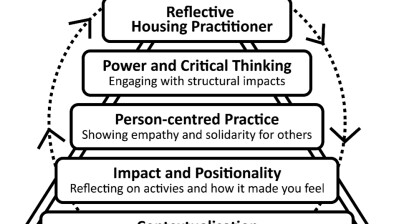Jill Pritchard: Occupational therapy and housing partners for health

Jill Pritchard
Jill Pritchard, an occupational therapist and workplace and business change consultant, highlights the transformational impact of housing solutions in helping people to live independently.
The role of occupational therapists working in the community is a critical one and covers a wide range of interventions including treatment, rehabilitation, enablement, housing solutions and much more.
Housing solutions are different for different people and span equipment, adaptations, technology, supporting individual’s rehousing and inclusive design of new build developments.
There are a number of housing occupational therapy posts across Scotland and this role enables us to specialise in working with people who experience a wide range of needs in relation to their housing situation.
It allows us to work closely with our housing colleagues across all tenures, spanning from housing associations and local authorities to owner-occupier/private lets.
It also means we are able to work in an integrated way with our health and social care partners.
The Housing OT role includes:
- Assessing existing tenants for a wide range of housing solutions – from simple grabrails and handrails that increase safety & independence and prevent falls & injuries to the conversion of bathrooms to wet floor shower rooms and including interventions to support cognitive & sensory challenges such as increased task lighting, improved signage and tonal contrast.
- Assessing people applying for rehousing on disability/ill-health grounds and identifying specific requirements in terms of design and adaptations.
- Matching applicants from the housing ‘waiting lists’ to available properties and recommending the equipment/adaptations/technology required to make a property fully suitable if needs
- Providing specialist input on inclusive design for new developments from the early stages of planning to enable the highest levels of accessibility generally and to get the best specialist designs possible, e.g. for fully wheelchair-accessible properties.
Budget crisis and its knock-on effects
In early October, we learned that funding to housing associations and social housing landlords from the Scottish Government, for adaptations for disabled and older people was significantly lower than expected to meet the needs anticipated.
Social landlords received only £8.2m, which is a 25% cut from their previous budget of £11m and a fraction of what the request for adaptation funding of £28.1m.
This cut in funding will have a knock-on effect in respect of delayed discharge and hospital admissions if people are not able to live safely and independently in their home.
Individual housing associations and the Scottish Federation of Housing Associations have raised their concerns over this cut and are urging the Scottish government to reinstate the required funding.
Occupational therapists working in this field often use the ‘Person, Occupation, Environment’ model, which maximises a person’s ability to take part in everyday living activities.
By everyday living, we mean all the things we do to take care of ourselves, maintain our health and home, connect with friends and family, engage in meaningful activities & hobbies, and support ourselves and our community through work and volunteering.
We work across all client groups; from children through to adults including transition, older people and people living with all types of health/disability challenges; physical and mental health, learning disability, cognitive and sensory, and increasingly a wide variety of neurodiversity challenges and complex needs.
Our work helps prevent hospital admission, supporting hospital discharge, enabling discharge from long term care and from long stay hospital wards.
The right home environment can reduce the need for other health and social care interventions, including care at home, care or residential home admission and hospital admission, and can support physical and mental health & well-being by enabling maximum participation in those activities which are meaningful for the person.
Meanwhile, several occupational therapists are supporting the ‘Coming Home’ agenda which provides housing and specialist interventions for people with very complex needs.
Some recent examples from housing occupational therapy colleagues include the following peoples’ stories -
An occupational therapist supported Mr A to move into a ground floor wheelchair accessible property direct from hospital.
This change meant most of the property was accessible for him, including the kitchen which in his previous home had been impossible for him to even get into using his wheelchair, while the shower-room required adaptations allowed him to be independent in selfcare. These included lowering the sink to allow it to be accessible and installing a wash dry toilet.
Without these adaptations and the accessible kitchen, Mr A required carers to visit 4 x daily to support him with a range of tasks.
The cost of home care per hour midweek is circa £22.19 and weekend £23.35
For a package of 2 hours per day (1 hour for showering and dressing followed by 2 x 15 mins for meals and 1 x 30 mins personal care/tuck) would be approximately £315 per week or £16,380 per year.
Another colleague shared their work with Mr B who had a health crisis and was admitted to hospital.
Mr B could not return to his previous property as it was unsuitable for the adaptations that he needed. Once medically fit for discharge, he was moved into a care home and was there for 6 months before being referred to the housing occupational therapist via her housing colleagues.
She carried out an assessment and identified a recent new build development with a suitable ground floor accessible property. The property was to be available in 6 months and only required a ceiling track hoist installation to make it fully suitable.
Mr B now only requires one carer to assist with hoisting and is fully independent otherwise.
Average residential care home costs - £825 per week = £42,900 per year
Occupational therapists working in social care and local authorities often get involved in similar types of examples but embedding OTs in housing can support improved and streamlined pathways and greatly enhance partnership working across wider health, social care and housing organisations locally.
- Jill Pritchard is a workplace change consultant & specialist housing occupational therapist. She is also chair of Horizon Housing Association.
This article was originally published in Health & Care News







